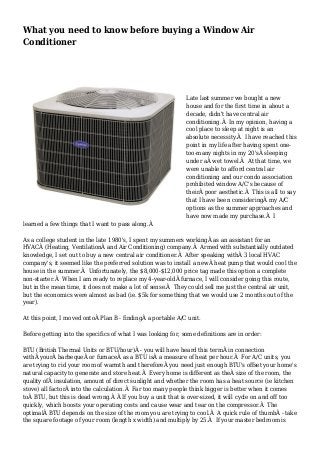
What you need to know before buying a Window Air Conditioner
- 1. What you need to know before buying a Window Air Conditioner Late last summer we bought a new house and for the first time in about a decade, didn't have central air conditioning. In my opinion, having a cool place to sleep at night is an absolute necessity. I have reached this point in my life after having spent one-too- many nights in my 20's sleeping under a wet towel. At that time, we were unable to afford central air conditioning and our condo association prohibited window A/C's because of their poor aesthetic. This is all to say that I have been considering my A/C options as the summer approaches and have now made my purchase. I learned a few things that I want to pass along. As a college student in the late 1980's, I spent my summers working as an assistant for an HVAC (Heating, Ventilation and Air Conditioning) company. Armed with substantially outdated knowledge, I set out to buy a new central air conditioner. After speaking with 3 local HVAC company's, it seemed like the preferred solution was to install a new heat pump that would cool the house in the summer. Unfortunately, the $8,000-$12,000 price tag made this option a complete non-starter. When I am ready to replace my 4-year-old furnace, I will consider going this route, but in the mean time, it does not make a lot of sense. They could sell me just the central air unit, but the economics were almost as bad (ie. $5k for something that we would use 2 months out of the year). At this point, I moved onto Plan B - finding a portable A/C unit. Before getting into the specifics of what I was looking for, some definitions are in order: BTU (British Thermal Units or BTU/hour) - you will have heard this term in connection with your barbeque or furnace as a BTU is a measure of heat per hour. For A/C units, you are trying to rid your room of warmth and therefore you need just enough BTU's offset your home's natural capacity to generate and store heat. Every home is different as the size of the room, the quality of insulation, amount of direct sunlight and whether the room has a heat source (ie kitchen stove) all factor into the calculation. Far too many people think bigger is better when it comes to BTU, but this is dead wrong.  If you buy a unit that is over-sized, it will cycle on and off too quickly, which boosts your operating costs and cause wear and tear on the compressor. The optimal BTU depends on the size of the room you are trying to cool. A quick rule of thumb - take the square footage of your room (length x width) and multiply by 25. If your master bedroom is
- 2. 24x20, you would need 12,000 BTU's to efficiently cool your space. As an aside, 12,000 BTU is also known as '1 ton' as this is the amount of heat required to melt a 1 ton block of ice in 24 hours. If you want to be a little more accurate with calculating your optimal BTU's, this link provides a good calculator. SEER (Seasonal Energy Efficiency Ratio) - This ratio is shown on your new A/C's "Energyguide" label and represents the cooling output per watt of electricity. In this case, bigger is better as a higher number indicates better efficiency. This ratio can be used to estimate the annual electrical cost (the industry assumes 1,000 hours of usage per year) by taking the A/C's BTU and dividing by the SEER, then taking the product and multiplying by the average cost per kilowatt-hour ($0.12 in the US in 2011). If the label to the right was for a 10,000 BTU A/C, the annual electrical cost would be $90.23/yr (or $0.09/hour). If you are buying your unit used, use the wattage shown on the model plate as the annual consumption, then multiply this number times $0.12. In determining which portable A/C I wanted to buy, I determined that I needed a 10,000 BTU unit for my master bedroom.  I then did Google and Amazon searches to find models that were well reviewed (based on noise, features, looks, etc), then narrowed the field down to 2 for a final analysis.   My short list looked as follows: Manufacturer: LG Frigidaire Model: LW1012ER FRA106CV1 Â
- 3. BTU: 10,000 10,000 SEER: 10.8  10.8 Cost @ Amazon: $279.00 $259.00 Annual Energy Cost (BTU/SEER * $0.12): $111.11  $111.11 Given that I would have been happy with either unit, I bought the Frigidaire as it has the lowest overall cost. Had the annual energy costs been different, I would have compared the 'all-in' cost over a 5 year time horizon. I have been very happy with my purchase and have been sleeping soundly ever since.